- Peperomia Serpens: How Easy It Is To Care For It? - September 24, 2021
- Best Indoor Fiberglass Planters Guide: Our Top Picks - September 6, 2021
- Peperomia Polybotrya: Is It Easy To Keep This Plant Alive? - August 31, 2021
The Cebu Blue Pothos is a rare plant that you can easily grow at home. Unlike the pothos varieties that have deep green leaves, or the interest patterns you see in variegated ones, the Cebu blue pothos has an interesting blue streak when the light shines on them at some angles.
What’s more, the Cebu blue pothos can look interesting as it matures. From having narrow leaves to something that resembles a monstera.
How can you take care of this plant at home? What’s the best way to care for a Cebu blue pothos? What are the things that you should avoid? Well, grab a chair and get comfy as we answer all these questions plus more.
How to Identify Cebu Blue Pothos
Epipremnum pinnatum ‘Cebu blue’ is quite rare. This plant is native to Cebu, Philippines, so it’s a tropical plant with needs similar to other pothos. The Cebu blue pothos has silvery-blue leaves that can shine when the angle of the light is right. You can let it trail or climb, depending on your preference.
The leaves of this plant have a tapering form, measuring around two by seven inches (5.1 to 17.8 centimeters). It’s commonly mistaken as a monstera, but Cebu blue pothos has a rougher and harder stem than a Monstera’s smooth stem.
Compared to other pothos varieties, the Cebu blue pothos doesn’t exhibit variegations. The leaves are also narrower and longer.
How to Grow Cebu Blue Pothos From Seed
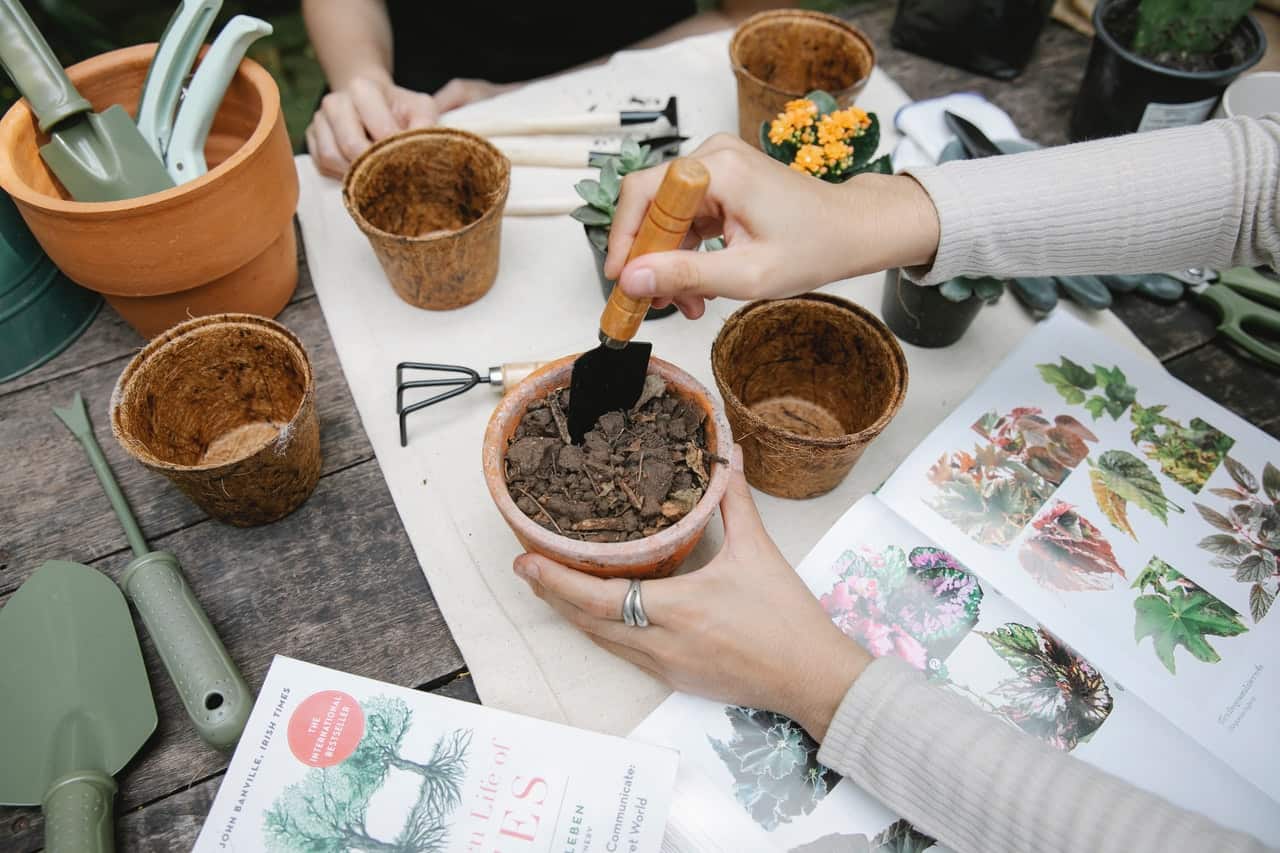
Unlike other pothos varieties, Epipremnum pinnatum plants do flower. The plants both have male and female flowers on spadix measure 3.9 inches (10 centimeters) long. The spadix has a greenish hue outside while being white or creamy white inside. The flowers eventually give way to fruits that, in turn, produce brown seeds.
To plant these seeds, you will need a well-draining potting mix or soil. Check out these products:
Put the potting mix or soil in a medium-sized pot and then sow the seeds. You should put the pot in a location that gets around two to three hours of sunlight. Water your seeds regularly and wait around one to two weeks for them to germinate.
How to Propagate Cebu Blue Pothos
However, the fastest way to propagate a Cebu blue pothos is by getting cuttings. Look for a healthy stem that has two or three leaves on it. Make sure that you get a longer cutting to not have problems putting it into water or soil. Cut the stem below a node or those joints where the leaves and the stems are attached. Give about 0.5 to one inch (1.3 to 2.5 centimeters) allowance.
Put the cutting in a jar or vase with water. If the bottom leaves are immersed in water, cut them away. Wait for the cuttings to develop roots before putting them into the soil.
Alternatively, you can plant these cuttings straight in fresh soil and just wait for them to grow. However, you have a better chance of propagating your Cebu blue pothos when you start them in water.
How to Plant a Cebu Blue Pothos
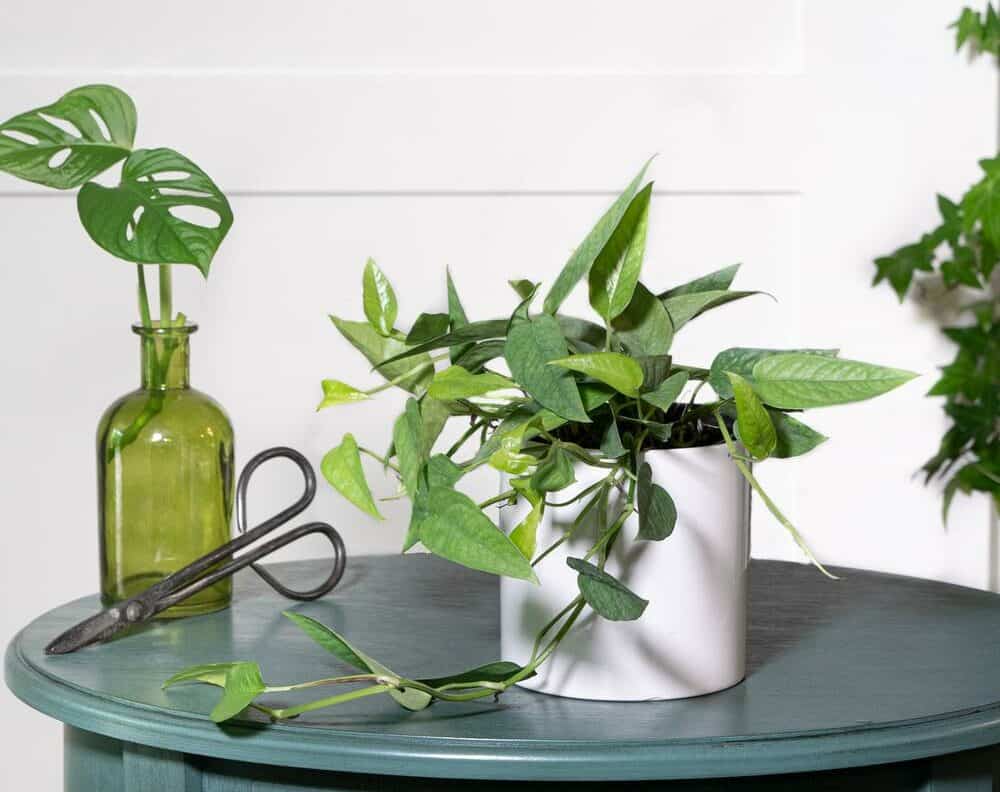
Now you know that you can grow a Cebu blue pothos from seeds or start it via cuttings. You will still need to take care of it. The easy step is putting the seeds into the ground, but the most satisfying step is to make sure that you keep the plant alive and healthy.
Cebu Blue Pothos Growing Conditions
You can grow your Cebu blue pothos inside your home, and they will thrive in normal humidity levels and temperatures that keep you comfortable around the house. So you do not have to go through too much of a hassle when you try to keep it healthy as a houseplant.
You can also grow it outdoors for as long as you give it the right conditions: bright indirect light, well-draining soil, regular watering, and feeding. And always remember that this is a tropical plant, so treat it as such. What are the specific care requirements for healthy Cebu blue pothos? Read on and find out.
Cebu Blue Pothos Potting & Soil
The good news is that a Cebu blue pothos will grow well in just about any type of soil. However, it does prefer well-draining potting soil that’s airy and light. You must avoid heavy clay soils. You can use ready mix potting mix and soil like the recommendations we have above. Or you can just augment ordinary garden soil with perlite and other materials.
You can watch this Organic Gardening video to find out how you can make your soil better draining:
Cebu Blue Pothos Water Requirements
How much water should you give your Cebu blue pothos? The Cebu blue pothos appreciates a thorough watering and then a few days or weeks of neglect. After making sure that the soil is thoroughly moist, you should wait until the top few inches of the potting mix are completely dry before giving it another drink.
Your Cebu blue pothos doesn’t appreciate getting its feet standing in water, which is the reason why you need well-draining soil to keep it healthy. Watering too much will actually hurt your plant more than under-watering. How can you tell when it’s the right time for another drenching? Your Cebu blue pothos will look wilted. Or it may have yellowed leaves.
Cebu Blue Pothos Light Requirements
Pothos, in general, is known for being the perfect houseplants because they are not fussy about lighting. You can put these plants in the shade, and they will continue to grow.
The Cebu blue pothos is the same. You will find it difficult to kill this plant even when you keep it in the darker areas of your home. However, if you want the pretty leaves to become even more beautiful and lush, you should keep these plants in an area with bright yet indirect sunlight.
You should never put your Cebu blue pothos under full sun. As such, if you’re growing it outside your home, you should find a place that’s getting a lot of shade from bigger plants.
Best Cebu Blue Pothos Fertilizer
Cebu blue pothos plants are easy to care for and are rather tolerant when you don’t give them the best growing conditions that they need. Another proof of how easy-going this plant is that you probably can get away with not fertilizing it, and it will still thrive.
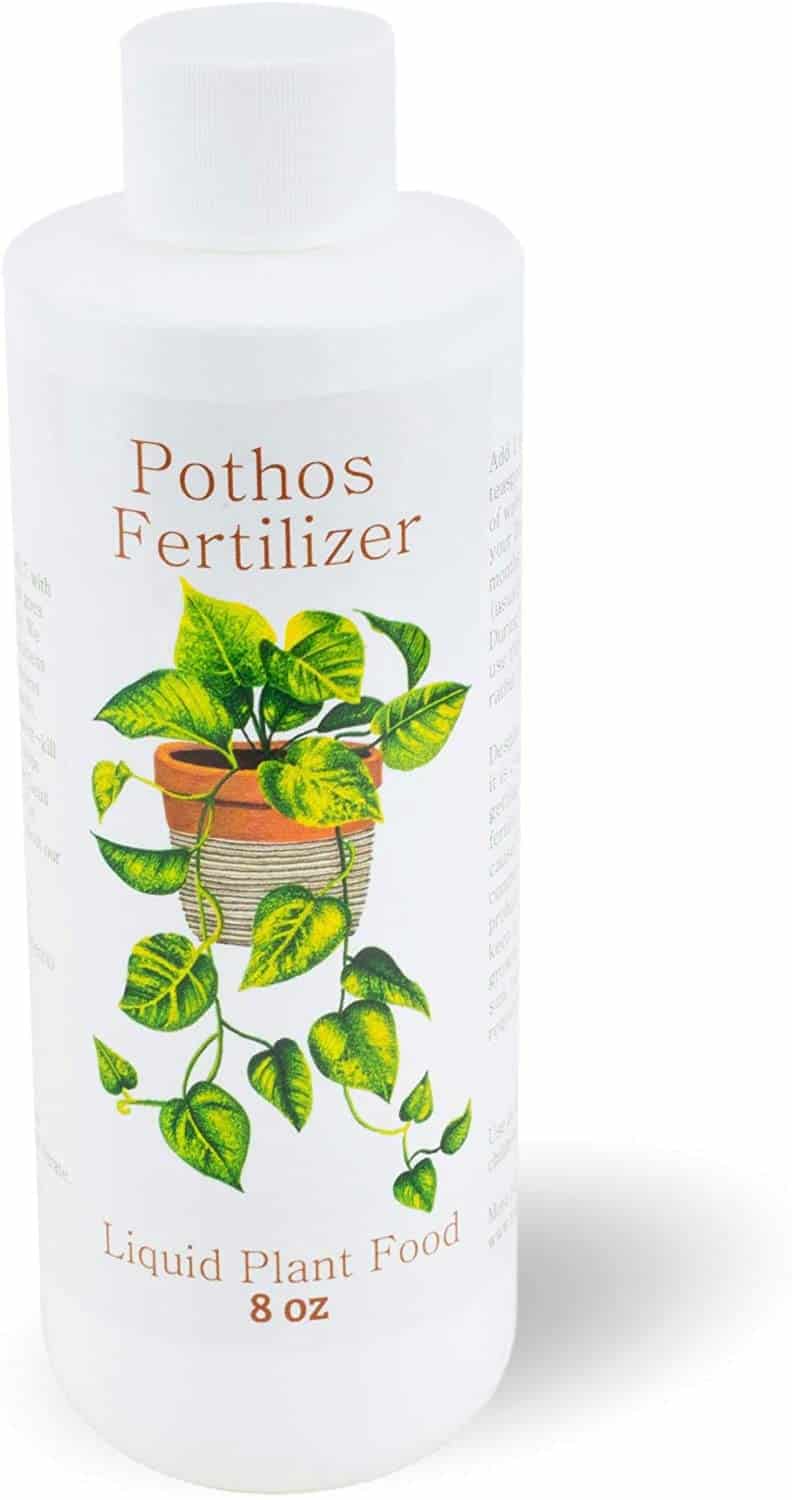
However, if you want to feed your Cebu blue pothos, you can give it a well-balanced fertilizer.
You can use these products to keep your Cebu blue pothos happy:
- Pothos Fertilizer
- Miracle-Gro Indoor Plant Food
- Joyful Dirt Premium Concentrated All-Purpose Organic Plant Food and Fertilizer
Best Cebu Blue Pothos Companion Plantings
There are various reasons why you should put your Cebu blue pothos in the same pot as another plant. First, you can save space and have two or more plants in the same container.
Also, you can have these companion plants support each other. You can also combine two plants with the same care requirements together, so it’s easier to grow different kinds of plants. You can also make your Cebu blue pothos more interesting by adding another plant that can break the monotony of its silvery-blue or green leaves.
For instance, a dracaena has the same requirements as your Cebu blue pothos. You will not have to fret about overwatering one of them while underwatering the other. They also prefer medium to low light and are not voracious feeds.
As such, it’s okay to put them together in the same pot and care for both in the same way. Plus, the pothos can climb on the dracaena, which makes it look interesting. Other plants that you can try putting in the same pot as your Cebu blue pothos are:

Spider plants come from tropical regions, and their green and white leaves can contrast nicely with the shiny bluish silver that the Cebu blue pothos has. Snake plants are like Cebu blue pothos in that they are easy to care for. These plants tolerate a variety of lighting, watering, and soil conditions.
Asparagus ferns give you light green foliage with fronds. This color can complement the dark green leaves that have an interesting texture.
Cebu Blue Pothos Diseases and Common Problems
One of the many reasons people like caring for a Cebu blue pothos is that it is not prone to insect attacks, pests, and diseases. But you might want to make sure that you have your eyes peeled for mealybugs or spider mites.
Some diseases can affect several varieties of pothos, including Cebu blue.
- Bacterial leaf spot: When your pothos develops wet spots that have yellow edges. This can spread quickly on the leaves. These are caused by the Pseudomonas cichorii bacteria.
- Pythium root rot: Your cutting does not develop a healthy root system and has yellow leaves. The older leaves are also yellow and die, while stems turn mushy and black.
- Rhizoctonia stem rot: The stems that touch the soil die, and there is visible fungal growth on the soil surface.
Cebu Blue Pothos Treatments and Maintenance
When you have problems with insects and pests attacking your backyard, you can easily protect your Cebu blue pothos. When it comes to insects, there are several ways to get rid of them. For instance, mealybugs can be eradicated by putting isopropyl alcohol on cotton and then swabbing them on the mealybugs.
For other insects, you can get rid of them using natural products such as Safer 5182-6 Brand Neem Oil Concentrate or Garden Safe Brand Insecticidal Soap Insect Killer. Meanwhile, those who like to protect their Cebu blue pothos from any type of pest and diseases can get something like the Safer Brand SF5462 5462-6 3 in1 Garden Spray Concentrate, which gets rid of fungi, insects, and mites.
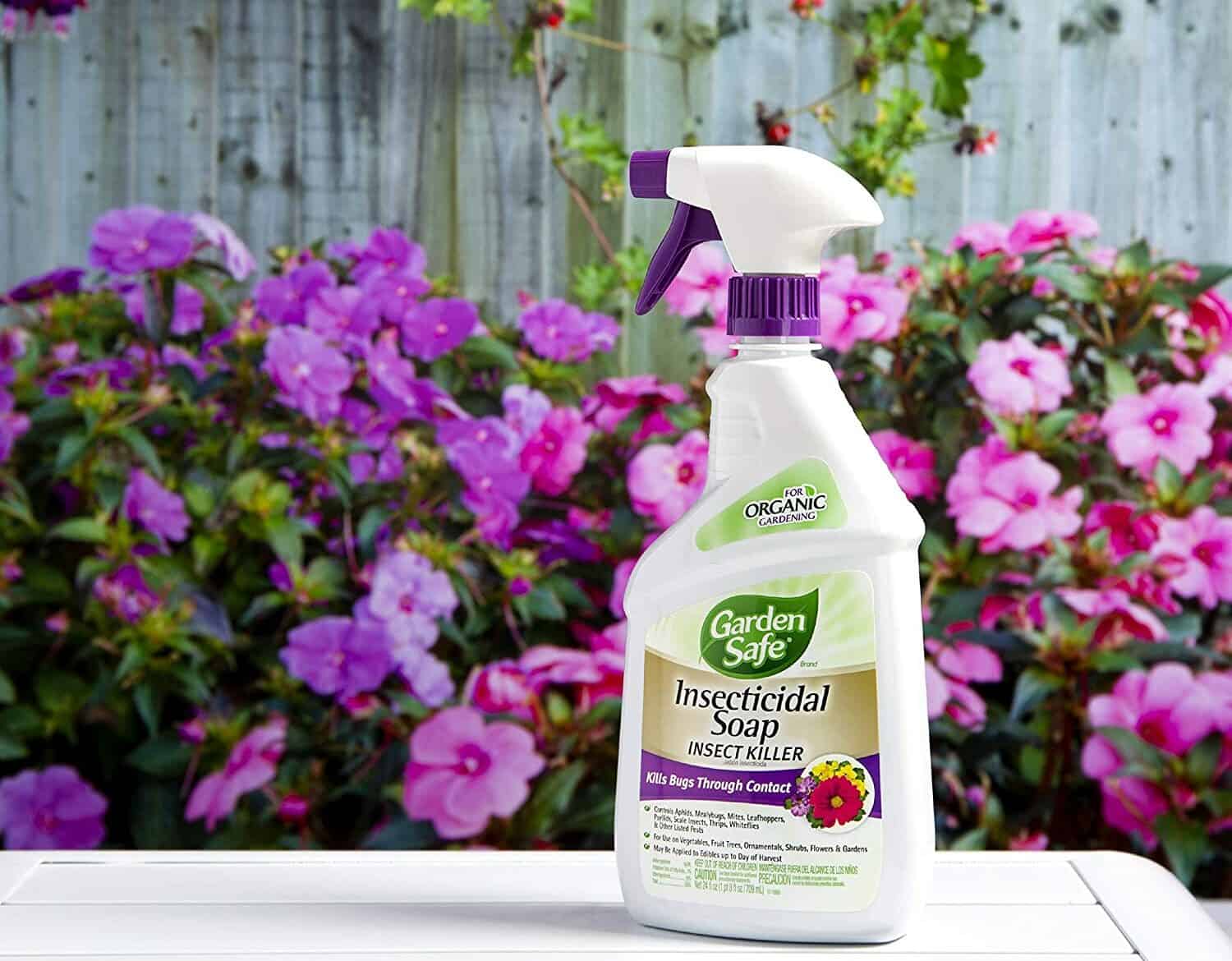
Pruning
There is no real need for you to prune your Cebu blue pothos. However, you might want to cut back on the unruly leaves if it grows fast.
If you want it to climb, be sure to put a moss pole in the same pot so that your pothos can have some support. Aside from pruning to make your pothos look beautiful, you should also train them so that it looks fuller and less leggy.
Repotting and Pots for Your Cebu Blue Pothos
Your Cebu blue pothos will grow fast, and you might need to be repotted every year. In general, you will need to report your Cebu blue pothos every 12 to 18 months. Putting it in a slightly larger pot that is bigger by one to two inches (2.5 to 5.1 centimeters) than your current pot will help make your plant grow better. The roots will have room to expand and stretch out and grow.
Repotting your Cebu blue pothos will also give it fresh nutrients from the potting mix or soil that you use in the new pot. If you have a Cebu blue pothos in a bigger floor pot, then you might want to repot every 18 to 24 months. Choose a two to four-inch pot (5.1 to 10.2 centimeters) bigger than your current pot.
Tips When Repotting Cebu Blue Pothos
- The best time to repot any type of pothos is in the spring or summer when your plant is at its strongest and is actively growing.
- If you want to use the same pot, you should still replenish the soil so that your plant will get fresh nutrients. What’s more, you should cut away and reduce the roots while also cutting back on the leaves.
- You can choose several types of pots for your Cebu blue pothos. You can use one without a drainage hole, but because these plants can fall victim to root rot, you might want to get a pot that has one. Some of the pots we recommend include:
- Standard planters like these La Jolíe Muse White Ceramic Plant Pots give your Cebu blue pothos a modern-looking and stylish home.
- Self-watering planters, such as this HBServices USA Self Watering and Self Aerating High Drainage Deep Reservoir Round Planter Pot, are perfect for those who would like to put their Cebu blue pothos on top of shelves, bookcases, and other hard to reach places. You will not have to water your plant frequently while still ensuring that it gets all the water it needs.
- Hanging baskets like the TAMAYKIM Ceramic Hanging Planters Set allow you to let your Cebu blue pothos hang and trail.
Where to Buy Cebu Blue Pothos Seeds and Mature Plants Online
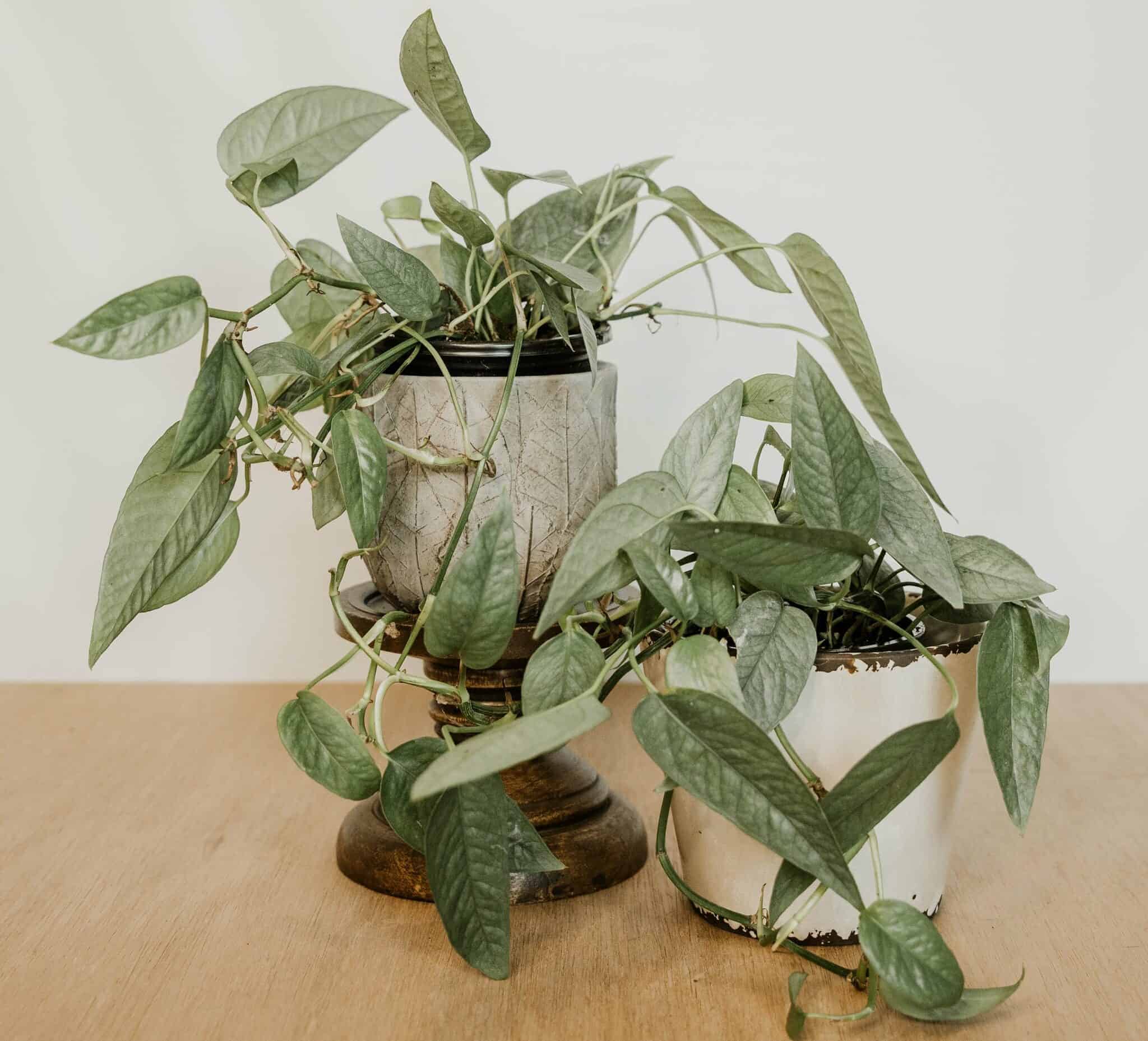
Unfortunately, there seem to be no online retailers for Cebu blue pothos seeds. However, you have quite a selection of retailers online that sell live plants and cuttings.
Etsy has some sellers that offer Cebu blue pothos. These can range from rooted cuttings with one leaf and whole plants with denser foliage. These are also sellers that sell mature Cebu blue pothos plants.
Similarly, you can get some lovely potted Cebu blue pothos on eBay. Other online shops you can check out are:
FAQs
Question: Is this plant safe for pets?
Answer: As beautiful as these plants are, the Cebu blue pothos is toxic to animals. So if you have pets or small children, it might be a good idea to choose another indoor plant.
Question: Do Cebu blue pothos plants have fenestrations?
Answer: One of the reasons the Cebu blue pothos is often mistaken as a monstera is because it develops fenestrations when it matures. As a young plant, the Cebu blue has thin and pointy leaves without holes.
But mature plants have leaves with zig-zag splits, often spanning from the midribs of the leaves to the edges. The thing with Cebu blue pothos is that it takes too long to reach maturity, sometimes taking up to two decades before the fenestrations show up on its leaves.
That’s good news because you get to enjoy the silvery-blue glint of its leaves for a very longs time.
Question: Help! What should I do when the leaves of my Cebu blue pothos turn yellow?
Answer: When your Cebu blue pothos has yellow leaves, it may be a sign that you’re not watering it enough. Aside from the yellowing, the leaves will also feel crisp to the touch, and the soil will be completely dry. If this is the case, rescue your Cebu blue by thoroughly watering it.
There are times when your Cebu blue pothos is overwatered. When this happens, the leaves will lose color and gradually fade. It will then die.
Young leaves on a Cebu blue will be lighter in color, with some leaves having a greenish-yellow hue. The young leaves will be shiny too.
If you see this coloration, know that it is normal for young leaves. They will mature in a week or two and begin having that blue hue.
Cebu Blue Pothos: Grow This Rare Plant Today!
If you want a plant that’s easy to care for and has an amazing blue tint in the leaves, you should not be afraid of growing the Cebu blue pothos. It’s rare yet perfect for beginners. It’s also an excellent way to add to your pothos or houseplant collection.
Research Citations
- Bark and Vine Shop: Cebu Blue Pothos
- eBay: Cebu Blue Pothos
- Etsy: Cebu Blue Pothos
- Flore de la Terre: Golden Pothos Companion Plants
- Garden Beast: Epipremnum pinnatum Guide: How to Grow & Care for “Tibatib”
- Greenery Unlimited: Pothos Care
- Hirt’s Gardens: Rare Cebu Blue Pothos – Epipremnum Pinnatum – 4″ Pot
- House Plant Hobbyist: Cebu Blue Care
- Housefur: Companion Houseplants for Your Home: Benefits and Examples
- Indoor Plant Addicts: Cebu Blue Pothos
- PennState Extension: Pothos Diseases
- Planterina: Cebu Blue Pothos
- Soil Seed and Garden: Cebu Blue Pothos
- Steve’s Leaves: Epipremnum Pinnatum ‘Cebu Blue’
- Windy City Aquariums: Cebu Blue Pothos
- YouTube: Improving clay soil into the best potting mix and potting soil for gardening

